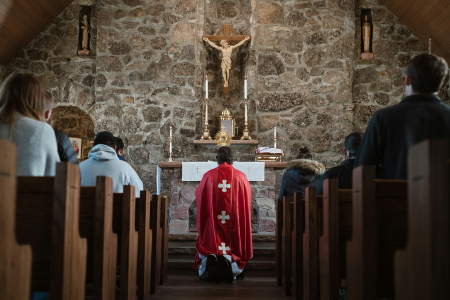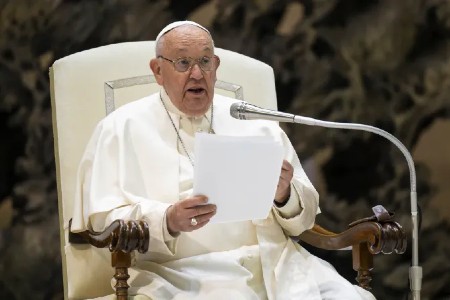We ask you, humbly: don't scroll away.
Hi readers, it seems you use Catholic Online a lot; that's great! It's a little awkward to ask, but we need your help. If you have already donated, we sincerely thank you. We're not salespeople, but we depend on donations averaging $14.76 and fewer than 1% of readers give. If you donate just $5.00, the price of your coffee, Catholic Online School could keep thriving. Thank you.Help Now >
Liturgy of Jerusalem
FREE Catholic Classes
The Rite of Jerusalem is that of Antioch. That is to say, the Liturgy that became famous as the use of the patriarchical church of Antioch, that through the influence of that Church spread throughout Syria and Asia Minor , and was the starting point of the development of the Byzantine rite, is itself originally the local liturgy, not of Antioch, but of Jerusalem. It is no other than the famous liturgy of St. James. That it was actually composed by St. James the Less, as first Bishop of Jerusalem, is not now believed by any one; but two forms in it show that it was originally used as local rite of the city of Jerusalem. There is a reference to the Cross among the prayers for catechumens --"Lift up the horn of the Christians by the power of the venerable and life-giving cross"--that is always supposed to be a reference to St. Helena's invention of the True Cross at Jerusalem in the early fourth century. If so, this would also give an approximate date, at any rate for that prayer. A much clearer local allusion is in the Intercession, after the Epiklesis : "We offer to thee, O Lord, for thy holy places which thou hast glorified by the divine appearance of thy Christ and by the coming of thy Holy Spirit " (these are the various sanctuaries of Palestine) "especially for holy and glorious Sion, mother of all Churches" (Sion, in Christian language, is always the local Church of Jerusalem. See JERUSALEM.) "and for thy holy Catholic and Apostolic Church throughout the whole world" ( kata pasan ten oikoumenen , which always may mean, "throughout the whole Empire"). This reference, then, the only one to any local Church in the whole liturgy -- the fact that the Intercession, in which they pray for every kind of person and cause, begins with a prayer for the Church of Jerusalem, is a sure index of the place of origin.
We ask you, humbly: don't scroll away.
Hi readers, it seems you use Catholic Online a lot; that's great! It's a little awkward to ask, but we need your help. If you have already donated, we sincerely thank you. We're not salespeople, but we depend on donations averaging $14.76 and fewer than 1% of readers give. If you donate just $5.00, the price of your coffee, Catholic Online School could keep thriving. Thank you.Help Now >
We have further evidence in the catechetical discourses of St. Cyril of Jerusalem. These were held about the year 347 or 348 in the Church of the Holy Sepulchre ; it is obvious that they describe the liturgy known to his hearers there. Probst has examined the discourses from this point of view ("Liturgie des IV Jahrhunderts", Muster, 1893, 82-106) and describes the liturgy that can be deduced from them. Allowing for certain reticences, especially in the earlier instructions given to catechumens (the disciplina arcani ), and for certain slight differences, such as time always brings about in a living rite, it is evident that Cyril's liturgy is the one we know as that of St. James. As an obvious example one may quote Cyril's description of the beginning of the Anaphora (corresponding to our Preface ). He mentions the celebrant's versicle, "Let us give thanks to the Lord", and the answer of the people, "Meet and just". He then continues : "After this we remember the sky, the earth and the sea, the sun and the moon, the stars and all creation both rational and irrational, the angels, archangels, powers, mights, dominations, principalities, thrones, the many-eyed Cherubim who also say those words of David : Praise the Lord with me. We remember also the Seraphim, whom Isaias saw in spirit standing around the throne of God, who with two wings cover their faces, with two their feet and with two fly; who say: Holy, holy, holy Lord of Sabaoth. We also say these divine words of the Seraphim, so as to take part in the hymns of the heavenly host" ("Catech. Myst.", V, 6). This is an exact description of the beginning of the Anaphora in the Liturgy of St. James.
We have, then, certain evidence that our St. James's Liturgy is the original local rite of Jerusalem. A further question as to its origin leads to that of its relation to the famous liturgy in the eighth book of the Apostolic Constitutions . That the two are related is obvious. (The question is discussed in ANTIOCHENE LITURGY.) It seems also obvious that the Apostolic Constitution rite is the older; St. James must be considered a later, enlarged, and expanded form of it. But the liturgy of the Apostolic Constitutions is not Palestinan, but Antiochene. The compiler was an Antiochene Syrian ; he describes the rite he knew in the north, at Antioch. (This, too, is shown in the same article.) The St. James's Rite, then, is an a adaptation of the other (not necessarily of the very one we have in the Apostolic Constitutions, but of the old Syrian rite, of which the Apostolic Constitutions give us one version) made for local use at Jerusalem. Then it spread throughout the patriarcate. It must always be remembered that, till the Council of Ephesus (431), Jerusalem belonged to the Patriarchate of Antioch. So this liturgy came to Antioch and there displaced the older rite of the Apostolic Constitutions. Adopted unchanged at Antioch (the local allusion to "holy and glorious Sion" was left unaltered), it imposed itself with new authority as the use of the patriarchical Church. The earliest notices of an Antiochene Rite that we possess show that it is this one of St. James. There is no external evidence that the Apostolic Constitution rite was ever used anywhere; it is only from the work itself that we deduce that it is Syrian and Antiochene. Under its new name of Liturgy of Antioch, St. James's Rite was used throughout Syria, Palestine, and Asia Minor. When Jerusalem became a patriarchate it kept the same use.
 Hi readers, it seems you use Catholic Online a lot; that's great! It's a little awkward to ask, but we need your help. If you have already donated, we sincerely thank you. We're not salespeople, but we depend on donations averaging $14.76 and fewer than 1% of readers give. If you donate just $5.00, the price of your coffee, Catholic Online School could keep thriving. Thank you. Help Now >
Hi readers, it seems you use Catholic Online a lot; that's great! It's a little awkward to ask, but we need your help. If you have already donated, we sincerely thank you. We're not salespeople, but we depend on donations averaging $14.76 and fewer than 1% of readers give. If you donate just $5.00, the price of your coffee, Catholic Online School could keep thriving. Thank you. Help Now >
The Liturgy of St. James exists in Greek and Syriac. It was probably at first used indifferently in either language, in Greek in the Hellenized cities, in Syriac in the country. Of the relation of these two versions we can say with certainty that the present Greek form is the older. The existing Syriac liturgy is a translation from the Greek. There is good reason to suppose that at Jerusalem, as everywhere else, the primitive liturgical language was Greek. The schismatical Monophysite Churches formed in the fifth and sixth centuries in Syria kept St. James's Rite in Syriac. The Orthodox used it in Greek till it was supplanted by the daughter-rite of Constantinople about the twelfth century. At present the old Rite of Jerusalem is used, in Syriac, by the Jacobites and Uniat Syrians, also in a modified form in Syriac by the Maronites. The Greek version has been restored among the Orthodox at Jerusalem for one day in the year -- 31 December.
Join the Movement
When you sign up below, you don't just join an email list - you're joining an entire movement for Free world class Catholic education.
-

-
Mysteries of the Rosary
-
St. Faustina Kowalska
-
Litany of the Blessed Virgin Mary
-
Saint of the Day for Wednesday, Oct 4th, 2023
-
Popular Saints
-
St. Francis of Assisi
-
Bible
-
Female / Women Saints
-
7 Morning Prayers you need to get your day started with God
-
Litany of the Blessed Virgin Mary
U.S. Catholic Parishes Experience Resurgence of Traditional Practices
-

Pope Francis Urges Faith and Prayers for Peace
-

Florida Welcomes Volunteer Chaplains to Public Schools
-
10 Fascinating Details About St. Joseph the Worker: Celebrating His Feast Day - May 1
-
St. Joseph the Worker: Model for Men, Young and Old
Daily Catholic
 Daily Readings for Thursday, May 02, 2024
Daily Readings for Thursday, May 02, 2024 St. Athanasius: Saint of the Day for Thursday, May 02, 2024
St. Athanasius: Saint of the Day for Thursday, May 02, 2024 The Our Father: Prayer of the Day for Thursday, May 02, 2024
The Our Father: Prayer of the Day for Thursday, May 02, 2024- Daily Readings for Wednesday, May 01, 2024
- St. Marculf: Saint of the Day for Wednesday, May 01, 2024
- To Saint Peregrine: Prayer of the Day for Wednesday, May 01, 2024
![]()
Copyright 2024 Catholic Online. All materials contained on this site, whether written, audible or visual are the exclusive property of Catholic Online and are protected under U.S. and International copyright laws, © Copyright 2024 Catholic Online. Any unauthorized use, without prior written consent of Catholic Online is strictly forbidden and prohibited.
Catholic Online is a Project of Your Catholic Voice Foundation, a Not-for-Profit Corporation. Your Catholic Voice Foundation has been granted a recognition of tax exemption under Section 501(c)(3) of the Internal Revenue Code. Federal Tax Identification Number: 81-0596847. Your gift is tax-deductible as allowed by law.








 Daily Readings for Thursday, May 02, 2024
Daily Readings for Thursday, May 02, 2024 St. Athanasius: Saint of the Day for Thursday, May 02, 2024
St. Athanasius: Saint of the Day for Thursday, May 02, 2024 The Our Father: Prayer of the Day for Thursday, May 02, 2024
The Our Father: Prayer of the Day for Thursday, May 02, 2024

